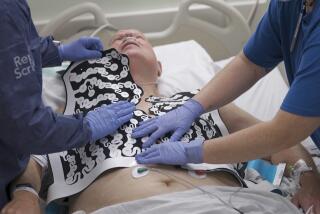Heart Assist Pumps Found to Revive Cells
- Share via
The dying heart cells of many people with heart failure can be brought back to life with the help of a mechanical pump that temporarily takes over their function--a finding that could dramatically alter the future treatment of the nearly 5 million Americans with congestive heart failure.
Cardiologists have always assumed that, once damaged, heart tissues could never recover. But a new report in today’s Circulation, the journal of the American Heart Assn., confirms a growing number of anecdotal reports that damaged cells can regain much of their normal function.
A team from the Temple University Cardiac Transplant Center reports that the pumps, called left ventricular assist devices or LVADs, can resuscitate damaged heart cells--and may, in some cases, eliminate the need for a heart transplant.
“These findings represent the first report of improved function in human heart cells . . . with any form of therapy,” said Dr. Kenneth B. Margulies of Temple.
*
About 2,300 heart transplants are performed in the United States each year to replace hearts that have grown too weak to circulate enough blood through the body. Victims have difficulty breathing and retain fluids throughout their bodies, and the heart continues to deteriorate in a downward spiral.
But donor hearts are rare and, at any given time, as many as 4,000 people may be on the waiting list for a transplant.
To keep such patients alive long enough for a donor to be found, surgeons have recently begun to install an LVAD, a miniature electric pump that is surgically implanted in the abdomen and connected to tubes that route blood from one of the heart’s pumping chambers into the circulatory system.
Although researchers are working to develop LVADs that can be permanently implanted, the current devices can be used only for a few months at best. At that point, physicians have always thought, a heart transplant would still be necessary.
But the new findings suggest otherwise.
“Instead of our original concept that LVADs represent a ‘bridge to a transplant,’ we can now begin to think of them as a ‘bridge to recovery,’ ” said Dr. Eduardo Marban of the Johns Hopkins University School of Medicine. “That is a very significant change in thinking.”
Margulies and his team studied 22 patients with severe heart failure, each of whom was connected to an LVAD for an average of 111 days before undergoing a transplant.
They collected heart cells, called myocytes, from each patient at the time that they were placed on the device and again when the transplant was performed.
In failing hearts, the myocytes have a greatly diminished ability to contract, or beat, and a slowed rate of relaxation before the next contraction. They also do not respond well to adrenaline-like substances, such as norepinephrine, that cause the heart to speed up when more blood supply is needed.
But in the myocytes removed after the patients had been on the LVADs, all of these functions were significantly improved. The rates of contraction and relaxation were three times as fast as they had been before the LVADs were implanted and the cells responded much better to stimulants.
“These results clearly demonstrate that failing myocytes can regain some degree of their previously normal function and are not irreversibly damaged,” Margulies said. “Even the most [damaged] failing heart still has enough recoverability that we can see improvement in functional parameters.”
Margulies cautioned that the results were observed only in isolated cells “and we don’t know if the whole organ will recover.”
Dr. Daniel Marelli of UCLA, however, noted that cardiac surgeons in Texas and Germany have successfully weaned a few patients from the devices without the need for a transplant. “But we don’t know the long-term results at all,” he said. “Many of those patients may come back with heart failure again.”
According to Marban, “there are hints that some drugs can do the same thing.” In treatment of patients with congestive heart failure with the class of drugs called beta-blockers, “not only does the [failing] heart become stable, but in some cases it actually gets better. That would have been absolute heresy in the dogma that we all learned only a few years ago.”
UCLA’s Marelli also has shown that heart assist devices can rescue patients with heart failure that develops suddenly, such as that caused by certain viral infections. One example of such a recovery is that of 25-year-old Jennifer Weldon of Granada Hills.
Weldon was found to have bronchitis in December. As her condition deteriorated, she was admitted to Holy Cross Hospital, where cardiologists said her heart was so damaged that she had only a 2% chance of survival.
She was rushed to UCLA on Dec. 23, where Marelli installed an assist device to replace the function of both her right and left ventricles in hopes of keeping her alive long enough for a donor heart to be located.
Within 14 days, her heart had recovered enough for Marelli to remove the device, made by Abiomed Inc. “I didn’t feel very good then, but at least I was alive,” Weldon said Monday.
Although Weldon suffered nerve damage to her leg when her condition was at its worst, she is experiencing a virtually complete recovery and expects to return to her job as a nurse next month. She has been undergoing cardiac rehabilitation on a treadmill and a stationary bicycle, she said, and her heart “has healed completely.”






